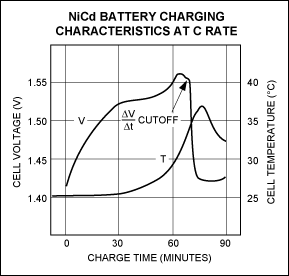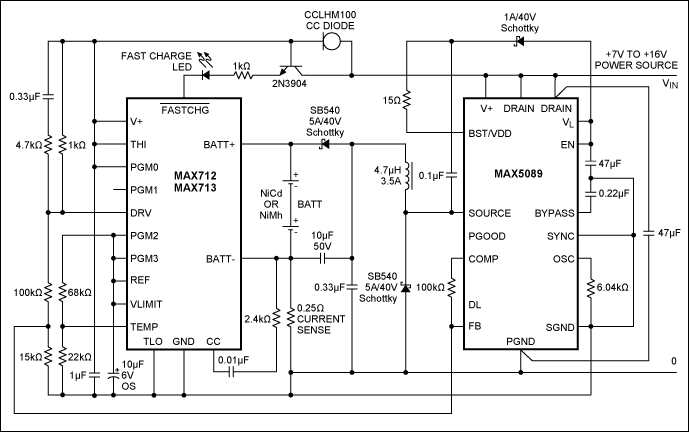NiMH/NiCd Switchmode Battery Charger Has dV/dt Charge Termination
要約
This circuit includes a battery charger (MAX712) and step-down switching regulator (MAX5089) for handling the power portion of the charger. By controlling the regulator the MAX712 acts as a battery-charge controller, producing outputs of 7V to 16V. It operates from any DC source capable of delivering the desired fast-charge current, with this condition: the output voltage must equal 1.7V multiplied by the sum of (two plus the number of batteries to be charged in series).
A similar version of this article appeared in the December 17, 2008 issue of Portable Design magazine.
All battery chargers can be regarded as constant-current power supplies, but they differ from power supplies in two important respects: battery chargers (by design) block all discharge paths from battery to charger, under any conditions. They also include circuitry that decides when the battery has taken a full charge (signaling when the full-charge current must be reduced), and when the charging process should be terminated.
Several techniques are available for deciding when a NiCd or NiMh battery is fully charged. The most common of these relies on terminating the charge when the battery terminals reach a particular voltage level, based on a characteristic increase in the positive slope of voltage versus time.
This is not the best method, because the absolute value of termination voltage depends strongly on the ambient temperature and the charge rate (the "C" rate). The final result can therefore be an under- or over-charged battery. Overcharging a NiCd or NiMh battery is not as serious as for lithium batteries, which are much more sensitive to damage. NiCd and NiMh batteries are more rugged devices. Undercharging is a problem, simply because the store of charge will be less than expected.
Most of the better termination methods rely on the fact that charging transforms electrical energy into stored (potential) chemical energy. Charging is an endothermic process. That means the battery temperature not only doesn't rise; it actually falls slightly during a charge.
When a battery reaches full charge, the reactions that transform electrical energy to chemical energy cease. Any further electrical energy forced into the battery by the charger transforms to heat, which increases the battery temperature. At that point charging should stop, because the battery has stored 100% of its capacity.
You can sense this temperature increase and use it as a signal for termination of charging, but that measurement implies a thermal sensor in intimate contact with the battery—not always a feasible arrangement. You can also sense the temperature increase by changes in the battery's terminal voltage, which is a sensitive indicator of internal temperature changes. Thus, charging a battery produces a positive slope in the plot of voltage versus time. The positive slope turns negative when a NiCd battery reaches full charge, and goes to zero (flat) when a NiMh battery reaches full charge.
Figure 1 shows the terminal voltage vs. time for a NiCd battery under charge. The time scale for change of slope, which can range from minutes to tens of minutes according to the battery size, depends on the thermal time constant of the battery and its enclosure. It also depends on the charge rate (i.e., the charging current), because the temperature increase and its rate of increase are functions of the battery's thermal capacity and of power delivered (which, in turn, is a function of charging current).

Figure 1. These curves show the voltage and temperature characteristics of a NiCd cell as it approaches and passes the fully charged condition.
To detect slope changes, the charge controller must run a detection algorithm that makes sequenced voltage measurements at long time intervals and then stores the results for comparison. This capability, which cannot be implemented in analog form, must be performed by a combination of ADC, memory, timer, and sequencer.
IC battery chargers such as the MAX712 (for NiMh batteries) and MAX713 (for NiCd batteries) run dV/dt slope-sensing charge-termination algorithms. The power section of these devices is linear and has limited efficiency, but is adequate for smaller-capacity batteries.
The circuit of Figure 2 includes a MAX712 or MAX713 battery charger, and also a switching regulator (MAX5089) that handles the power portion of the charger. This regulator operates at higher efficiency and a higher switching frequency (2MHz), which in turn enables construction of smaller-size chargers capable of higher fast-charge rates, yet with little need for heat-sinking.

Figure 2. This switchmode charger for NiCd and NiMh batteries uses their dV/dt behavior as an indicator for charge termination.
The MAX5089 step-down regulator is controlled by the MAX712 or MAX713, acting as a battery-charge controller. It produces outputs of 7V to 16V and operates from any DC source capable of delivering the desired fast-charge current, with this condition: the output voltage must equal 1.7V multiplied by the sum of (two plus the number of batteries to be charged in series).
The Figure 2 circuit charges a pack of 1 to 8 cells with fast-charge currents as high as 2.5A, and retains all programmable features described in the MAX712/MAX713 data sheets. When charging is complete, the MAX712/MAX713 devices go to a state called "trickle charge," in which they inject a small fraction of the full charge current (to compensate for the self-discharge always present). You can therefore leave the battery connected to the charger, and find it charged to +100% when needed. Data sheets for the MAX712/MAX713 and MAX5089 are available at www.analog.com.